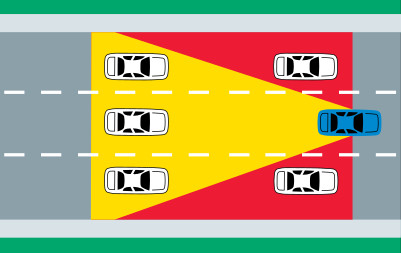 Do you leave yourself an out when you are driving? A defensive driver always tries to maintain a space cushion around all four sides of their vehicle. The habit gives them both time to decide and a place to go if a problem occurs.
Do you leave yourself an out when you are driving? A defensive driver always tries to maintain a space cushion around all four sides of their vehicle. The habit gives them both time to decide and a place to go if a problem occurs.
Leave Yourself an Out
This is the fourth key practice in the Smith System of safe driving. It is an active role rather than a reactive one and requires continual thought and adjustment as the conditions change around your vehicle.
Following Distance
Most drivers are familiar with the need to keep at least two seconds following distance between themselves and the vehicle in front of them. This space gives you time to react when things go wrong. It also gives you more room to see what is going on further ahead on the highway and avoid problems before you become involved in them.
What's Behind You?
Keep a cushion behind your vehicle as well. One way to deal with a tailgater is to make more room in front of you so that the tailgater has more time to react if something happens. Another is to slow down slightly and encourage them to pass, or pull over and stop to let them by. Trading a minor inconvenience for increased safety is always worthwhile.
Space to Changes Lanes Into
Never match speeds with the vehicle travelling beside you on multi-lane highways, especially at intersections or freeway exits. Offset your vehicle to the front or rear so that you have a place to change lanes into if the need arises. This will also avoid having someone collide with you if they don't check properly before a lane change.
Blind Spots
Choose your offset position wisely, remembering not to drive in another driver's blind spot. If you cannot see the other driver's face through the side window or in their rear view mirror, they probably can't see you either.

Even in small vehicles, the roof pillars can hide objects as large as your vehicle from a driver's view. The view you have of the other driver is not always the same as the view they have of you.
There are huge blind spots for drivers of transport trucks, including right in front of their vehicle. Never remain in the "No Zone" where the driver cannot see you.
Stopping at Traffic Lights
The need to keep a safe space around your vehicle does not end when you stop at a traffic light. You should always see pavement between the front of your hood and the back tires of the vehicle in front of you after stopping.
This precaution helps prevent being pushed into the vehicle in front of you if you are rear ended. It also allows you room to move out of the way and make room for emergency vehicles to pass.
Use Your Signals
All vehicles come with a built in tool to help maintain safe space margins, the signal lights. Using signals properly tells other drivers what you would like to do and allows them to adjust to maintain their space margin as well as yours.
Share This Article
But what should you do, if all of the traffic on the highway with you is exceeding the speed limit by, say, 5 km/h to 10 km/h?
Stictly adhere to the limit (whereby cars will constantly be getting too close to your rear bumper, and/or passing you so that your out constantly disappears)?
Or deliberately drive with the best space cushion you can manage, to reduce the chance of collision?
- Log in to post comments
When I have a tailgater on me, I turn on my four way flashers. This usually causes them to back off. Works most of the time.
- Log in to post comments
- Log in to post comments

Good advice.